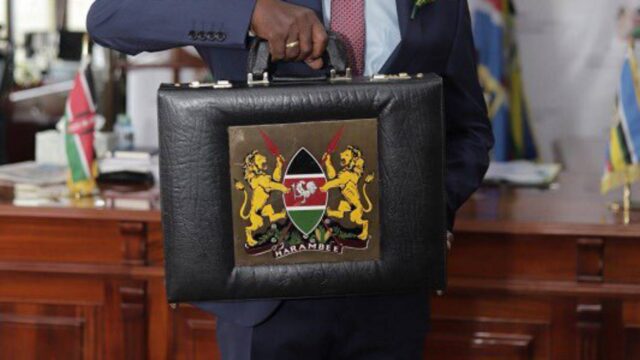2025/26 Budget: Experts outline options for CS Mbadi to lift Kenyan economy
Parliamentary Budget Office outlines key strategies to stimulate job creation, enhance productivity, and address revenue shortfalls.

The government must strike a careful balance between promoting economic growth and managing budgetary restraints as it prepares for the 2025/26 financial year, budget experts suggest.
The latest budget options report by the Parliamentary Budget Office outlines key strategies to stimulate job creation, enhance productivity, and address revenue shortfalls.
“The strategies emphasise fiscal responsibility and efficiency in public expenditure and targeted investments in high-growth sectors to maximise economic potential and drive sustainable development,” the 16th edition of PBO’s Budget Options Report states.
The experts say that challenges such as rising debt servicing costs, stagnating tax revenues, and global economic uncertainties remain significant hurdles. The PBO concludes that Kenya’s 2025/26 budget will be a crucial indicator of the government’s ability to balance fiscal discipline with economic expansion.
Although there are plans to increase revenue and decrease deficits, the largest obstacle is still ensuring that they be implemented effectively. Kenya runs the risk of long-term fiscal restrictions that could jeopardise long-term economic stability and social development in the absence of substantial structural reforms.
Kenya’s economy is projected to grow at 4.6 per cent in 2025, supported primarily by the services and agriculture sectors. The services sector, which has accounted for over 65 per cent of GDP, is expected to drive most of this growth, while the industrial sector struggles with sluggish manufacturing and construction activity. Agriculture is expected to contribute 17.1 per cent of GDP, aided by favourable weather conditions and government subsidies.
Despite this optimism, key risks persist. The PBO report warns that Kenya’s economic recovery remains fragile due to climate change effects, external shocks, and high inflation. The government’s ability to implement fiscal and structural reforms will be crucial in sustaining growth momentum.
The government has continued to struggle with revenue collection. Despite increased taxation measures, ordinary revenue as a share of GDP has stagnated at 14.5 per cent. Income tax, which accounts for a significant portion of revenue, has declined as a percentage of GDP, indicating economic strain on businesses and individuals.
On the expenditure side, the government is pursuing fiscal consolidation by reducing development and net lending from 4.2 per cent to 3.4 per cent of GDP. However, debt servicing remains a major burden, with KSh 653.5 billion spent on interest payments in the first half of FY 2024/25 alone. This significantly limits fiscal space for critical infrastructure and social programs.
A notable concern is the accumulation of non-disbursed committed loans totalling KSh1.38 trillion, which has led to financial penalties in commitment fees. The report urges more efficient utilisation of concessional loans to avoid unnecessary costs.
Despite economic growth, job creation remains sluggish. The informal sector continues to dominate employment, with 16.7 million out of 20 million employed individuals working informally. Formal employment has grown at just two per cent annually, failing to keep pace with labour market demands.
Additionally, real wages have consistently declined since 2020, reducing household purchasing power. This is particularly concerning given rising inflation and the cost-of-living crisis affecting many Kenyans.
The report proposes several strategies to enhance economic resilience. The first is the revitalisation of rural electrification by expanding the Petroleum Development Levy Fund to support last-mile connectivity with KSh 9 billion.
The report also proposes the creation of investment vehicles to attract remittances and link diaspora capital with local businesses. It also proposed an allocation of KSh500 million for the maintenance of the National Optic Fiber Backbone Initiative (NOFBI) to enhance digital services.
The experts also say that there is a need to address education financing challenges by consolidating bursary schemes and increasing allocations to KSh20 billion. The report also shows that the experts are suggesting that the government should target sector-specific investments to foster private sector-led growth.
“This includes investments in key agricultural value chains, including horticulture, which is a key export area with significant potential for growth, employment generation, and export revenue enhancement,” the report states.
It is also calling for regulatory reforms to facilitate a favourable business environment and enhance market access while urging for sustained efforts in securing regional and global markets for Kenyan products in line with existing Economic Partnership Agreements (EPAs).
The report states that the 2025/26 budget must enhance allocation to development expenditure in order “to boost individual income and household purchasing power through the feedback loop, thus stimulating consumption, investment, and overall economic activity.”
To create jobs, the budget experts are suggesting that the budget must enhance focus on developing the leather product value chain. They suggest the provision of KSh715.3 million towards the revitalisation of livestock feed production and conservation, including the establishment of feedlots.
They are also urging the government to provide KSh3 billion annually to support the establishment of fully equipped extension service stations in all the 1,450 wards across the country.
They also propose the allocation of KSh300 million to clean up all hides and skins and use them for value addition and KSh600 million to complete the attendant facilities at Kenya Leather Industrial Park—Kenanie.
The experts also suggest that allocating KSh500 million for the maintenance and rehabilitation of the NOFBI cable and KSh600 million to fastrack the completion of the 290 Constituency Industrial Development Centres (CIDHs) across the country can help in job creation and enhancing productivity.
